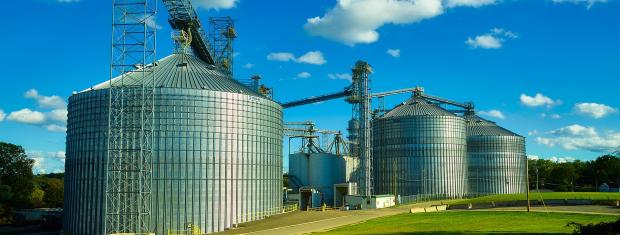
Grain Storage Bins: 3 Crucial Hazards to Keep in Mind
Grain handling facilities are those that may handle, store, receive, process and ship bulk raw agricultural commodities such as oats, barley, corn, wheat, etc. These facilities include feed mills, flour mills, grain elevators, dry corn mills and much more. As with much of the work in the agricultural industry, grain handling is a task that exposes workers to a variety of serious and life threatening hazards:
Dust Explosions and Fires
According to OSHA there have been over 500 explosions in grain handling operations across the U.S. over the last 35 years, which have injured more than 675 and killed more than 180 people. The main source of these explosions is grain dust, which is highly combustible and has the potential to explode when it becomes airborne or accumulates on a surface where it finds an ignition source. OSHA standards require that both grain dust and ignition sources must be controlled in grain elevators to prevent these often deadly explosions.
Tips to Prevent Explosions and Fires
- Create and execute a written housekeeping program including instructions to reduce dust accumulations on floors, ledges, equipment and other exposed surfaces.
- Identify “priority” housekeeping areas in grain elevators. OSHA describes these areas as those within 35 feet of inside bucket elevators, enclosed areas containing grain dryers and floors of enclosed areas containing grinding equipment. Dust accumulations should not exceed 1/8th inch in priority areas.
- Ensure all bucket elevators have been purchased after March 30, 1998 and that they have a surface electrical resistance not exceeding 300 megohms. Ensure your bucket elevator has an opening for the head pulley section and boot section to allow for inspection, cleaning, and maintenance. Bucket elevators must be equipped with a motion detection device that will shut-down the elevator when the belt speed is reduced by no more than 20% of the normal operating speed.
- Employ a preventative maintenance program including regularly scheduled inspections of mechanical and safety control equipment. There are a variety of methods you can use to start the program such as utilizing vibration detection methods, heat sensitive tape or other heat detection methods.
- Control hot work like welding, cutting, or brazing to minimize ignition sources.
- Install electrical and wiring that is suitable for hazardous locations.
- Design and appropriately locate dust collection systems.
- Install an efficient means of extracting ferrous materials from grain streams to ensure it does not enter equipment such as pulverizers, hammer mills and grinders.
Engulfment
Five seconds. That’s how fast a worker can become buried in flowing grain and unable to get out. The leading cause of death associated with grain storage bins is suffocation caused by engulfment (Purdue University Grain Entrapment Report). Suffocation can occur when a worker becomes buried by grain as they attempt to remove grain buildup or walk on moving grain inside of a bin. Moving grain acts like “quicksand” and can bury a worker in seconds. Workers should not enter grain storage bins without using proper equipment, precautions and training.
Tips to Prevent Engulfment
When workers enter a grain bin, they must always:
- Lock out and power down all powered equipment accompanying the bin, including equipment used to move the grain, so it is not being emptied or moving out or into the bin. Moving grain out of the bin whilst a worker is in it will create a suction that can engulf the worker in seconds.
- Forbid walking down grain and similar exercises where an employee walks on grain to make it flow.
- Equip all employees with a body harness including a lifeline, and ensure it is secured before the employee enters the bin.
- Create an observer station outside of the bin so a properly trained and equipped observer can provide assistance if needed. Ensure the observers sole task is to monitor the employee inside of the bin.
- Educate all employees on the specific hazardous work operations they will be performing when entering and working inside of the bin.
- Determine if there is sufficient oxygen within the bin by testing the air prior to entry for combustible materials and toxic gas.
- If air is not clean, vent hazardous atmospheres to ensure that sufficient oxygen levels are maintained.
- Make sure a permit is issued for each time a worker enters the bin.
Falls from Heights
Grain bins are massive structures that contain many opportunities for severe injuries. Some of the surfaces a worker can fall from include floors, roofs, skylights, ladders, machinery, structures, catwalks, manlifts and much more. Falls can also occur outside of the facility, as workers move from the vertical exterior ladders on grain bins to the bin roof or through a bin entrance. Ensure workers are trained on where these vulnerabilities lie as well as procedures to follow if an injury occurs.


